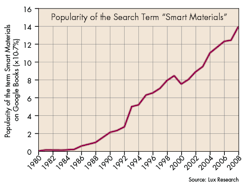The term “smart material” originated over 30 years ago to refer to any material capable of changing its properties automatically in response to an external stimulus. The stimulus and response may be mechanical, electrical, magnetic, optical, thermal, or chemical. Since then, popular and academic interest in the topic has risen steadily. This trend is shown in the graph below of the rising frequency of the two-word term “smart materials” in print sources as tracked by Google Books (the y axis indicates how often the phrase “smart material” occurs as a percentage of all two-word phrases). Today, a host of conferences, journals, and textbooks focus on smart materials.
There are many classes of smart materials, including well-known types such as piezoelectric, thermoelectric, electrochromic, photochromic, thermochromic, self-healing, and shape-memory materials. In some cases, these materials have been in commercial use since before World War I. In addition, to date there have been more than 330,000 global patents on piezoelectric materials and more than 70,000 involving thermoelectric materials. These materials are ubiquitous in applications ranging from consumer electronics to robotics to laboratory and industrial equipment.
However, the commercial relevance of smart materials in and of itself as a category of related-materials technologies is essentially nonexistent. There are few start-ups and major corporate R&D efforts targeting the field of smart materials as a whole. A search of the global patents on smart materials (shown in the figure below) corroborates this. We identified just 779 patents (and none before 1991) mentioning the term “smart materials.” In addition, unlike most emerging materials, the rate of patent activity is spiky rather than steadily increasing:
There is thus a clear disconnect between how commercial and non-commercial entities view smart materials. On the one hand, there is growing academic and popular interest focused on smart materials as a general class. On the other hand, companies are disinterested in the general class, but highly interested in particular subsets and types of smart material.
Why the disconnect?
For one, the term “smart materials” is too broad to be instrumentally useful in solving particular commercially relevant problems. The category encompasses solids and liquids, as well as polymers, alloys, ceramics, composites, and nanomaterials. Smart materials range from the piezoceramics in inkjet printers to shape-memory alloys in aerospace to self-healing polymer coatings. Any particular commercial R&D effort will draw on, at most, a couple of the more than a dozen of classes of smart materials. As a result, advances in most branches of the field of smart materials will be irrelevant to most companies actually using or considering using particular types of smart materials.
Additionally, the more commercially mature classes of smart materials do not need to be part of a larger category to prove their value. Piezoelectric, thermoelectric, and electrochromic materials plainly meet the definition of a smart material by changing their shape, temperature, or color in response to voltage, but producers and users of these materials do not typically bother to mention this point in patents or otherwise, because everyone involved knows their usefulness.
Conversely, the umbrella term “smart materials” serves to increase general awareness and interest in emerging, or simply less well-known, subcategories like shape-memory composites and thermoresponsive polymers. These materials benefit from a generalized interest in smart materials in the form of increased early-stage research. Highlighting the connection to more mature smart materials further reinforces the potential of these new materials classes to have large future commercial impacts.
This is not a new pattern. The term “nanotechnology” was similarly hyped for many years, but companies soon realized the term includes a large number of individually important or high-potential technologies with a common scientific feature that were nevertheless functionally unrelated to one another. Interest in the general category dropped substantially. Today, Lux Research estimates that “nano-enabled products” are a trillion-dollar market (of which the nanomaterials themselves represent a tiny fraction).What matters, though, is whether each individual technology solves a problem, not whether it uses a nanomaterial.
Smart materials are the new nano: a “smart material-enabled product” market size would similarly total at least in the high hundreds of billions of dollars. It would, for example, include cameras, smartphones, inkjet printers, hard drives, and a host of other products. Nevertheless, that figure is not useful until we dissect out the individual materials and their relevance to particular applications. In the world of nanotechnology, there have indeed been many cases where using nanomaterials and nanostructuring of materials has resulted in improved products, novel materials capabilities, and new markets. The same is true in smart materials—with the caveat that some smart materials, like piezoelectric ceramics, have a century-long head start on mass commercialization compared to nanotechnology. A key question, then, would seem to be: For what kinds of problems are smart materials likely to be an appropriate solution?
The history of the older families of smart materials (including, for example, piezoelectric, magnetocaloric, and electrochromic materials) show quick initial adoption in niche applications, followed by decades-long lag time before mass commercialization. At first glance, such a long (and variable) time horizon for commercial mass adoption would seem to make smart materials an unattractive field for R&D or investment.
However, today’s emerging smart-material classes could follow a different path. These classes include self-healing materials, coatings with damage sensing, chemical sensing, friction changing, hydrophobicity changing capabilities, and materials with several “smart” capabilities. One feature these classes of material technologies share is that they do not typically or primarily rely on new materials chemistries. Instead, they derive smart properties from structural patterning, often at the micro- or nanoscale, of already known material chemistries.
Deriving useful functions from structural patterning complexity is a distinction smart materials share with a growing collection of future materials platforms, including metamaterials, 3D printing, and indeed many nanomaterial products like nano-enabled coatings and nanocomposites. Research into all of these emerging material platforms have led to advances in material and part design, modeling, and simulation that could significantly shorten development cycle times—in some cases, from years to weeks. There is no reason the same should not be possible in smart materials, and indeed a recent paper, Smarter Actuator Design with Complementary and Synergetic Functions on multifunctional smart materials relied on custom modeling software that researchers claimed offers a general method for designing structures with desired smart properties.
In the long run, as these kinds of software tools for material and part design become more common and sophisticated, developers may be able to define, on demand, materials with exactly the set of properties their application demands. This situation opens new possibilities.
In a world of on-demand custom 3D-printed smart metamaterials, the question with which we began—for what kinds of problems are smart materials likely to be an appropriate solution? —is inadequate. The key question, instead, is simply: What problem is the part or product trying to solve?
As an example, in 2014 GM began adopting a shape-memory wire in the Corvette C7 in place of a motorized actuator as a weight-saving measure. It is unlikely any engineer at GM set out to add smart materials to the Corvette. Instead, shape-memory alloys turned out to be a plausible, though highly non-obvious, solution to the problem of reducing vehicle weight. Those alloys also reduce mechanical complexity by replacing a complex assembly with a single substance.
In the coming years, advances in smart-material design and production will open the door to using smart functionalities in many applications. However, as with metamaterials and additive manufacturing, identifying and seizing those opportunities will be far from easy. For the first movers, adoption will depend on a willingness to question basic, often invisible assumptions about how even common and well-established parts and processes should operate.
About the Author
Anthony Vicari
Advanced Materials team member
Anthony Vicari is a member of the Advanced Materials team at Lux Research where he covers technological and market developments in emerging materials and manufacturing technologies, including composites, coatings, and metals. He also covers longer-term, potentially disruptive innovations such as metamaterials, smart materials, additive manufacturing, and graphene. Prior to joining Lux Research, Anthony was a R&D Scientist at InnovX Systems, developing improved elemental analysis for handheld x-ray fluorescence spectrometers. Anthony earned an M.S. in Materials Science and Engineering from Carnegie Mellon University, and a B.A. (magna cum laude) in Physics and Chemistry from Harvard University.


